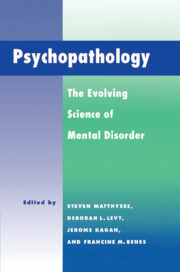Book contents
- Frontmatter
- Contents
- List of Contributors
- Preface
- Brain mechanisms
- Development
- Thinking
- Genetics
- 20 Editors' introduction: Contemporary issues in the genetics of psychopathological disorders
- 21 Genetic and environmental factors in the etiology of schizophrenia
- 22 Problems and paradoxes in research on the etiology of schizophrenia
- Comments on Einar Kringlen's chapter
- 23 Epistemological issues in psychiatric research
- 24 Searching for major genes for schizophrenia
- 25 The Drosophila eye and the genetics of schizophrenia
- Response and reflections
- Author index
- Subject index
22 - Problems and paradoxes in research on the etiology of schizophrenia
Published online by Cambridge University Press: 04 May 2010
- Frontmatter
- Contents
- List of Contributors
- Preface
- Brain mechanisms
- Development
- Thinking
- Genetics
- 20 Editors' introduction: Contemporary issues in the genetics of psychopathological disorders
- 21 Genetic and environmental factors in the etiology of schizophrenia
- 22 Problems and paradoxes in research on the etiology of schizophrenia
- Comments on Einar Kringlen's chapter
- 23 Epistemological issues in psychiatric research
- 24 Searching for major genes for schizophrenia
- 25 The Drosophila eye and the genetics of schizophrenia
- Response and reflections
- Author index
- Subject index
Summary
Our knowledge concerning schizophrenia has increased during the last decades. Nevertheless, a number of fundamental questions are still unresolved. Data from twin and adoption studies make it certain that there are both genetic and environmental components of the development of schizophrenia. However, the natures of the genetic and of the environmental contributions are, so far, not clear.
During the 1960s, ideas about psychosocial causation in schizophrenia were rife. Since then, empirical research has not been able to document with certainty any specific etiologic social factors. In contrast, during the last 15 years neuroscientific research has put the brain back in schizophrenia research. A number of new empirical findings have emerged. It is sufficient to mention the work on eye tracking by Holzman and co-workers, and the recent observations obtained through new imaging techniques, described in Chapter 4, by Martha Shenton, this volume. However, we still do not know how specific these deviations are, nor do we know their origin and etiological meaning. Thus it is also difficult, at the present stage, to incorporate the various empirical findings in one theoretical model. I am therefore afraid that I shall pose more questions than I shall provide answers.
We should keep in mind some of the fundamental problems and paradoxes in research on the etiology of schizophrenia. First, we are confronted with uncertainty regarding the clinical boundaries of schizophrenia. It makes, of course, a large difference whether one considers the “spectrum disorders,” such as paranoid, schizotypal and schizoid personality, as part of the schizophrenia concept.
- Type
- Chapter
- Information
- PsychopathologyThe Evolving Science of Mental Disorder, pp. 488 - 508Publisher: Cambridge University PressPrint publication year: 1996
- 2
- Cited by



